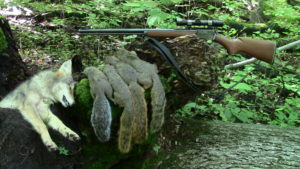By Glen Wunderlich

A good morning hunt with the Marlin Original Golden 39 A topped with a Leupold fixed 4x rimfire scope
Small game hunting season begins in a week and that means it’s time to dust off that favorite rimfire rifle and sight it in. Actually, that part is already done for me and what a joy it was!
However, if you don’t mind eating a few BBs, any old shotgun will work fine. Just load up the smoothbore, hike among the oak and hickory timber and blast away with whatever choke you have. There’s nothing to it, including skill.
Yes, I was that guy years ago until I graduated to the fine art of hunting with a .22 rifle. What follows are some tips and techniques to make your experience afield more enjoyable.

Most of today’s inexpensive rimfire firearms have terrible triggers right out of the box. If the trigger is not adjustable by the consumer, the accuracy will not be up to par in most instances. Most any scope and gun combination should be able to group shots within 1.5 inches at 50 yards but that’s the minimum level of accuracy to head afield with any ethical considerations. If a shooter is not able to meet these standards with the chosen rig, then getting closer to the target is the only option.
If your rifle is going to be scoped, make sure it’s a rimfire scope and not one designed for high-power rifles. The reason is that scopes that are not rimfire scopes have their parallax set to focus on targets at 100 yards or more – not squirrel-hunting range. And, it’s the closer range that will present optical illusions that some shooters will not recognize.
Here’s how to tell if you suspect a parallax issue: Set the rig on sandbags with crosshairs on a target. Without touching it, look through the scope at 50 yards or even less, then, move your head a bit while looking at the target. If the crosshairs appear to move, you have identified parallax. It’s a subtle malfunction that’ll drive a discriminating shooter bonkers.
Parallax adjustable scopes can solve this dilemma but messing around with a focus ring in a hunting situation is problematic, because squirrels have a way of changing the distance perpetually. Such optics may be good for target shooting, but not necessarily in the woods.
Choosing the proper ammo is important, as well. The bulk ammo in milk cartons is not typically accurate enough for me. In addition, most of it is supersonic, meaning its velocity is beyond the speed of sound or more than 1120 feet per second. That means it can be too destructive, especially in hollow-point configuration.
When I discovered the accuracy built into Lapua rimfire cartridges, I quit looking for anything better. (Olympic shooters use it, too.) To illustrate my rationale, I loaded my old Marlin Original Golden 39 A lever gun with a few rounds of Lapua Center X subsonic round-nose ammo and took three shots. The group measured less than ½ inch at 50 yards on the center X – right where I left it a year ago!
A quick check at 25 yards confirmed the bullets striking about an inch high. If there is a drawback to subsonic ammo, it is the fact that trajectory differences are magnified based on the slower velocity. Just make sure to shoot at various ranges to see how it may affect your groups. If $10 per box is too steep, check out other subsonic brands typically used for target shooting to save money. Also, make sure the ammo will cycle any semi-auto firearms properly.
Not only is subsonic ammo usually more accurate than the high-stepping fodder, it’s always quieter. And, that means a hunter can sit still and bag multiple squirrels from one stand with a little patience.
It’s not spray and pray with a scatter gun, but better tools for the job at hand can lead to a more enjoyable time afield.







